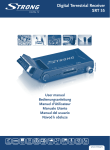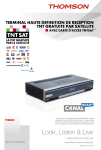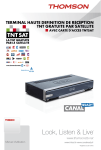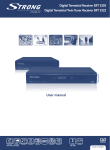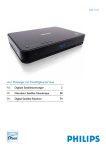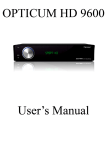Download Strong SRT 7100 TV set-top boxe
Transcript
Picture similar Digital High Definition Satellite Receiver SRT 7100 User Manual 1 3 2 Fig. 1 1 Fig. 2 Fig. 3 2 6 4 5 3 7 9 8 10 SCART Fig. 4 A B C HDMI Fig. 5 A B A Fig. 6 C A B C PART 1 • English 2 2 2 3 3 3 2.0 Your Receiver 2.1 DEFAULT PIN-CODE: 0000 2.2 Front Panel 2.3 Rear Panel 2.4 Remote Control Unit 3 3 3 4 4 3.0 Connections 3.1 Basic connection using a Scart cable 3.2 Basic connection using an HDMI cable 3.3 Connecting multiple fixed dishes using a DiSEqC 1.0 switch 3.4 Connecting and using the IR extender 5 5 5 5 5 4.0 Starting up for the first time 4.1 Language selection 4.2 System Setup 4.3 Satellite Selection 4.4 Scan Mode 4.5 Signal Adjust 4.6 Channel Setup 6 6 6 6 6 6 7 5.0 Quick guide to using your receiver 7 6.0 Operation 6.1 Changing channels 6.2 Info Banner 6.3 Selection of audio language 6.4 Teletext 6.5 Subtitles 6.6 Changing the video format 6.7 EPG (Electronic Programme Guide) 6.8 Instant Recording 6.9 Timeshift 7 7 8 8 8 8 8 8 9 9 7.0 Main Menu 7.1 Installation 7.2 Setup 7.3 Channel 7.4 Advanced 7.5 Games 9 9 11 13 16 17 8.0 TROUBLESHOOTING 17 9.0 SPECIFICATIONS 19 STRONG declares that this item complies with the basic requirements and other relevant regulations of directives CE 2004/108/EEC and 73/23EEC; RoHS 2002/95EEC Subject to alterations. In consequence of continuous research and development technical specifications, design and appearance of products may change. ASTRA is a registered trade mark of SES ASTRA, Eutelsat and HOT BIRD are registered trademarks of Eutelsat Communications, all other product names are trademarks or registered trademarks of their respective owners. © STRONG 2010. All rights reserved. 04/2010 * €0,14/Min. from German wired line * €0.42/Min. max. from mobile network * €0,12/Min. from Austrian wired line per March 2010 1.0 INTRODUCTION 1.1 Safety Instructions 1.2 Storage 1.3 Equipment Set-up 1.4 Accessories 1.5 Usage of external USB devices English Table of Contents * €0,14/Min. from French wired line 1 PART 1 • English 1.0 INTRODUCTION 1.1 Safety Instructions DO NOT INSTALL YOUR RECEIVER: In a closed or poorly ventilated cabinet; directly on top of or under any other equipment; on a surface which might obstruct the ventilation slots. DO NOT EXPOSE THE RECEIVER OR ITS ACCESSORIES: To direct sunlight or any other equipment that generates heat; to rain or intense moisture; to intense vibration and to any shock which may cause permanent damage to your receiver or to any magnetic objects, such as loudspeakers, transformers, etc. Do not use a damaged power cord. It may cause a fire or an electrical shock. Do not touch a power cord with wet hands. It may cause an electric shock. When the receiver is not used for a long period of time, you should unplug the power cord from the wall socket. Do not use alcohol or ammonia based liquids to clean the receiver. If you wish, you may clean your receiver with a soft lint-free cloth slightly made damp with a mild soap solution, only after disconnecting from the mains voltage supply. Make sure no foreign objects fall through the ventilation slots because this could cause fire or an electric shock. Do not place any objects on top of the receiver because this might prevent proper cooling of the components inside. Safety Precautions Never open the receiver cover. It is dangerous to touch the inside of the receiver due to high voltage currents and possible electrical hazards and your warranty will be void. Refer all maintenance or servicing to suitably qualified personnel. When you are connecting cables, be sure that the receiver is disconnected from the mains supply voltage. Wait a few seconds after switching off the receiver before you move the receiver or disconnect any equipment. It is a necessity that you only use an approved extension and compatible wiring that is suitable for the electrical power consumption of the installed equipment. Please ensure that the electrical power supply corresponds with the voltage on the electrical identification plate at the back of the receiver. If the receiver does not operate normally even after strictly following the instructions in this user manual, it is recommended to consult your dealer. 1.2 Storage Your receiver and its accessories are stored and delivered in a packaging designed to protect against electric shocks and moisture. When unpacking it, make sure that all the parts are included and keep the packaging away from children. For transporting the receiver from one place to another or if you are returning it under warranty conditions, make sure to repack the receiver in its original packaging with its accessories. Failing to comply with such packaging procedures could void your warranty. 2 PART 1 • English 1.3 Equipment Set-up English We recommend you consult a professional installer to set up your equipment. Otherwise, please follow the instructions below: Refer to the user manual of your TV and your antenna. Make sure that the SCART cable and outdoor components are in a good condition and the SCART connections are well shielded This manual provides complete instructions for installing and using this receiver. The following symbols will serve as follow. WarningIndicates warning information. TipsIndicates any other additional important or helpful information. MENURepresents a button on the remote control or the receiver (Bold Character) Move toRepresents a menu item within a window. (Italic Character) 1.4 Accessories User’s Manual Remote control unit IR Extender 2x Batteries (AAA type) 1 Note:The batteries should not be recharged, disassembled, electrically shortcircuited, be mixed or used with other types of batteries. 1.5 Usage of external USB devices It is recommended to use USB 2.0 storage devices. If your device is not compatible to USB 2.0 specifications, recording, playback and other multimedia functions of the receiver would not work properly. STRONG cannot guarantee compatibility to all types of USB storage devices. It is advised not to store important information on USB storage devices used with the receiver. Always make backups of data on your USB storage device before using it with this receiver. STRONG will not take responsibility for any loss of information or circumstances caused by loss of information. Please ensure that either the USB device is already formatted to FAT/FAT32, or format the USB device via your receiver, refer to chapter 7.3.3 File Explorer for details. 2.0 Your Receiver 2.1 DEFAULT PIN-CODE: 0000 2.2 Front Panel Fig.1 1. Standby/ON switchturns the receiver ON or to Standby 2. USB connectorconnect your USB device (stick, HDD, etc.) to this port 3. 4 digit LED displaydisplays channel number or time, depending on settings. 3 PART 1 • English 2.3 Rear Panel Fig 2. 1. SAT INTo connect to the LNB of your satellite dish for reception of satellite broadcast signal 2. SAT OUTTo loop through the satellite signal to a second receiver 3. IR To connect the IR extender 4. AUDIO (L/R)To connect to the audio input of your HIFI or television 5. S/PDIFTo connect to a digital or home cinema audio amplifier 6. VIDEO (RCA)To connect to the RCA video input of your TV or VCR using an RCA cable 7. TV SCARTTo connect to TV using a SCART cable 8. HDMITo connect to the HDMI input of your TV using a good quality HDMI cable. 9. Power switchTo switch the mains power ON or OFF 10. Power cordThe receiver requires a mains voltage of 100~240V AC 50~60Hz (auto selecting). Please check the local power conditions before connecting the receiver to the mains supply. 2.4 Remote Control Unit Fig. 3. qTurns the receiver ON/Standby !Mutes the audio output of the receiver [0~9]Channel number and numeric value input SATSatellite selection in normal viewing and channel mode TV/RToggles between TV and Radio mode MENUDisplays the menu in viewing mode or to go back one step in the menu EXITGo back one step in the menu/cancellation of current process/exit from main menu to viewing mode 8. pqSwitches to the next/previous channel in viewing mode or moving the highlight up/down in the menu 9. tuIncreasing/decreasing of the volume level in viewing mode or changing values of settings in the menu 10. OK Viewing mode:Displays the channel list. Menu: activation of the highlighted item 11. FAVToggles between available favourite groups and all channels list 12. EPGViewing mode: Displays the EPG (Electronic Program Guide) 13. V+/V-Increasing/decreasing of the volume level 14. INFOPress once to display channel number/name and now/next info. Press twice to display frequency/signal strength information. 15. AUDIODisplays the audio selection menu with selections for available languages and audio modes 16. V.FToggles between available HDMI screen resolutions 17. P+/P- Switches to next/previous channel in viewing mode 18. RED/RCLToggles between the current channel and the previous channel in viewing mode 1. 2. 3. 4. 5. 6. 7. 4 PART 1 • English English 19. GREEN/PAUSEFreezes/resumes the current broadcast 20. YELLOW/SUBDisplays a list of available subtitling for the current channel 21. BLUE/TEXTDisplays the teletext browser 22. 2Freezes/resumes the playback of recordings or music files 23. :Jumps to the previous track during MP3 playback 24. "Jumps to the next track during MP playback 25. 4Starts recording of the current broadcast 26. 1Starts playback of the selected file in File Explorer 27. 6Fast forward 28. 5Fast rewind 29. 3Stop 3.0 Connections 3.1 Basic connection using a Scart cable Fig. 4. AConnect the LNB of your satellite dish to the SAT IN connector of your receiver using a good quality coax cable and suitable ‘F-connector’ plugs. BConnect one end of a good quality Scart cable to the TV SCART connector on your receiver and the other end to the SCART input of your TV. CPlug the power cord to a suitable wall outlet. 3.2 Basic connection using an HDMI cable Fig. 5. AConnect the LNB of your satellite dish to the SAT IN connector of your receiver using a good quality coax cable and suitable ‘F-connector’ plugs. BConnect one end of a good quality HDMI cable to the HDMI output on your receiver and the other end to the HDMI input of your TV. CPlug the power cord to a suitable wall outlet. 3.3 Connecting multiple fixed dishes using a DiSEqC 1.0 switch Fig. 6. AConnect the LNB’s of your fixed dishes to the inputs of a DiSEqC 1.0 switch BConnect the output or “to receiver” connector of the DiSEqC 1.0 switch to the SAT IN connector on your receiver. CRefer to section 3.1 or 3.2 for TV and mains connections. 3.4 Connecting and using the IR extender The included IR extender allows you to place the receiver out of sight (e.g. in a closed cabinet) while still being able to control it. Plug the IR extender into the IR connector on the back of the receiver. Locate the extender on a position giving it direct sight to the remote control. Once a suitable location is found, remove the protecting foil from the adhesive tape on the back of the extender and fix it by slightly pressing it down on the surface it should be placed on. 5 PART 1 • English 4.0 Starting up for the first time Ensure that your satellite signal is of good quality and that all connections are sound. In case of difficulties or questions, please ask you local dealer for assistance. It is recommended to follow the Setup Wizard step by step. It will guide you through the basic installation and channel searching process. You can enjoy digital HD broadcasts within just a few minutes. 4.1 Language selection After turning on the power for the first time, the language selection menu will appear. Choose your language with pq and confirm with OK. A welcome screen will now be displayed. Once you are ready, press OK to start the wizard. During any stage of the Setup Wizard, you can press EXIT to get back to the previous screen. 4.2 System Setup Here you can set the Country, Aspect Ratio, Conversion Mode and Subtitle Language. Use pq to move the highlight and tu to change settings. To see a list of all possible settings for the highlighted option, press OK. Once all settings are made, move the highlight to NEXT and press OK to continue. 4.3 Satellite Selection Use pq to highlight the satellite your dish is aimed at and press OK to confirm. If your dish is aimed at Astra 1C, 1E, 1F, select ASTRA 19.2E. The SCAN MODE screen will appear. If your dish is aimed at HOT BIRD, select HOTBIRD 13E.The SCAN MODE screen will appear. If your dish is aimed at another satellite, select OTHER. You will be guided to the Satellite Settings menu. Refer to chapter 7.1.1 for instructions. Note:If Germany is chosen as country and ASTRA 19.2E as satellite, German preinstalled channels are available. An extra screen will then be displayed giving a choice between Preinstalled & Scan and Satellite Scanning. Choose Preinstalled & Scan to install the German pre-installed channels and continue with the Setup Wizard as described from point 4.4 or choose Satellite Scanning to continue without pre-installed channels. 4.4 Scan Mode Use pq to highlight the desired option and press OK to confirm. All: Will scan all available channels on the chosen satellite. Free: Will scan FTA (Free-To-Air) channels only. 4.5 Signal Adjust This screen allows you to fine tune the alignment of your dish antenna for optimum reception. Use tu to select the switch input the dish is connected to. (If the LNB of your dish is directly connected to the receiver, choose Switch Input 1) The bars on the bottom of the screen indicate the current signal strength and quality. A red bar indicates a bad signal. Green bars indicate a good signal. Yellow bars indicate that the signal condition is nearly acceptable. Adjust your dish for maximum possible signal quality and strength. Once the signal cannot be improved anymore, fix the dish on this position and press OK to continue. 6 PART 1 • English 4.6 Channel Setup English Your receiver will now perform an automatic channel search. Once the process is finished, all found channels will be stored and the receiver will switch to the first found channel. You are now ready to enjoy your new receiver. Note:If no channels were found during the automatic channel scan, the receiver will display the Satellite Settings menu. Please refer to chapter 7.1.1 for instructions. 5.0 Quick guide to using your receiver We at STRONG understand that you can’t wait to enjoy your new HD receiver. The following quick guide will make you familiar with the basic operation of this device. We do, however, advice you to read the full manual to get the best performance from your STRONG HD receiver. To turn your receiver ON or to Standby, use the q button on the remote control or the button on the left side of the front panel. Choose the desired channel with the pq buttons or the P+/P- buttons. Alternatively, you can digit the channel number with the [0~9] buttons on the remote control. Or press OK in viewing mode to display the channel list. The volume can be adjusted with the V+/V- buttons or the tu buttons. 6.0 Operation In viewing mode, several features are available to make watching TV a true pleasure. This paragraph describes these features. Please also read chapter 7.0 to get familiar with the menu of your new receiver. 6.1 Changing channels Your new receiver is equipped with three ways to change channels. via direct access via the channel list and via the P+/P- keys. 6.1.1 Direct access To gain direct access to a certain channel, simply input its number with the [0~9] key’s on the remote control. Channel numbers can be up to four digits long. Entering a number with less than four digits is possible. Just wait a few seconds and your receiver will switch to the selected channel. 6.1.2 Channel list Press OK in viewing mode to display the Channel List. Use pq in the Channel List to highlight your channel of choice and press OK once to select the highlighted channel. Press OK again to leave the Channel List. The Channel List is equipped with a filter function to make finding your favourite channels easier. While in the Channel List, press RED. An alphabet banner will now be displayed. Use pq to select the first letter of the desired channel and OK to confirm. All channels beginning with the chosen letter will now be displayed. 7 PART 1 • English The following keys are available in the Channel list and viewing mode: TV/R:Toggles between TV and radio channels SAT:changes the satellite FAV:to switch to one of the available favourite lists. 6.1.3 Using the P+/P- keys P+ or p will switch to a higher channel. P- or q will switch a lower channel. 6.2 Info Banner At any time during viewing mode you can press the INFO button to get info about the current channel and program*. Press INFO twice to see technical details about the current channel. * Program information is displayed when available. Availability depends from broadcast. 6.3 Selection of audio language Some channels support a choice of different audio formats and/or languages. To select another audio stream, press AUDIO in viewing mode. A list with available audio streams will now be displayed. Use pq to select the desired stream and confirm with OK. 6.4 Teletext Your receiver includes a fully featured Teletext. To access Teletext, press the BLUE button in viewing mode and use the [0~9] buttons to input the number of the page you wish to see. The coloured buttons of the remote control allow you to jump to selected pages directly, as indicated on the bottom of the teletext screen. Press EXIT to go back to viewing mode. 6.5 Subtitles Some channels support a choice of different DVB subtitle languages. Press SUB in viewing mode to display a list of available subtitle languages. 6.6 Changing the video format To change the video format while watching TV, simply press the V.F key in viewing mode. A list with available HDMI resolutions will pop up. Select the desired resolution using pq. It is also possible to change the Aspect Ratio or Conversion Mode from the Video Format banner. Use the tu buttons to select the option of choice and use pq to change to the setting. Once all settings are made, press OK to apply. 6.7 EPG (Electronic Programme Guide) The Electronic Programme Guide is a very useful function that allows you to watch programme schedules and information on screen and to mark programs for recording. Use pq to select the desired channel and u to move the highlight to the program list. In the program list, use pq to select or scroll through programs. Use OK to display detailed information about the selected program. Use RED to display program information for the next day and GREEN to get back one day. Simply press YELLOW to get back to today’s information. Note:Availability of EPG data depends on broadcast. 8 PART 1 • English 6.8 Instant Recording Your new receiver allows you to make an instant recording of the program you are watching. Simply press 4 to start the recording. To enter the duration for the recording, press 4 again. Use the [0~9] keys to input the desired recording time. During the recording a banner showing the elapsed recording time will be shown on the upper right of your TV screen. To stop the recording, press 3. * Please connect an USB storage device with sufficient free space before you start a recording. For recording HD broadcast, a high speed device is needed. 6.9 Timeshift The Timeshift function allows you to pause live broadcasts and resume normal watching without missing anything. Press 2 to freeze the current broadcast. Press 2 again to start time shifted playback. To stop Timeshift, press 3. Note:The Timeshift will only work correctly when a fast USB storage device such as an USB2.0 HDD is connected to the receiver. Distorted picture and / or audio during Timeshift indicate a low USB device speed. STRONG cannot guarantee for USB devices used. Especially when Timeshift is activated at channels with high data rate (High quality SD/HD), STRONG cannot guarantee an accurate Playback of the Timeshift file. 7.0 Main Menu All important settings and features of your receiver can be operated from the Main Menu. It consists of the following sub-menus: Installation, Setup, Channel, Advanced and Games. Use tu to select a sub-menu and pq to choose an option. Press OK to advance to the chosen submenu. Press MENU in viewing mode to display the Main Menu. 7.1 Installation The installation menu allows you to change satellite settings and to search for channels. It consists of the following sub-menus: Satellite Settings, Auto Scan, Manual Scan and Satellite Edit. Choose the desired sub menu with pq and press OK to advance. 7.1.1 Satellite Settings Use this menu to change the settings for a given satellite and to configure the parameters for the used antenna Use pq to highlight Satellite and tu to set the satellite you wish to change the settings for. To see a list with all available satellites, press OK when the highlight is on Satellite. Use pq to highlight 9 English Booking a program from EPG Select a program as described above. Once the desired program is selected, press BLUE. This will lead you to the timer menu. All details are already filled in for you. Make a choice between Play or Record action and save the timer. Please refer to section 7.3.4 for details. PART 1 • English Transponder and tu to set the desired transponder. Signal bars indicating signal quality and strength can be found on the bottom of the screen. These bars show the signal conditions for the chosen satellite and transponder. You can now adjust the following settings: LNB type, LO Frequency, LNB power, Band (22 kHz), Switch Type, Switch Input, Dish Mode and Dish Position. Once all settings are made, press exit to get to the previous menu or use pq to highlight Go To and tu to select Auto Scan or Manual Scan to advance to Auto Scan or Manual Scan. A confirmation banner will now be displayed. Press OK to confirm the made changes or EXIT to discard. 7.1.2 Auto Scan Use this menu to perform an automatic channel search on one or more satellites. On the left of the screen, a list with satellites is displayed. Use pq to highlight the satellite(s) you wish to scan and press OK to mark the highlighted satellite. Press OK again to unmark a marked satellite. Note:you can mark multiple satellites. Auto Scan will search all marked satellites for available channels. Now select the desired scanning options on the right of the screen. Use u pq to highlight and OK to set an option. Scan Mode All:scan all channels Free:scan Free-To-Air channels only Scrambled:scan scrambled channels only. Service Type All:scan TV and Radio channels TV scan:TV channels only Radio:scan radio channels only. Network Search Disabled:no network search Enabled:network search will be performed. Once all settings are made, press the GREEN button on the remote control to start the scan or EXIT to quit without scanning. All newly found channels will be stored at the end of the channel list. Tip:Network Search: If Disabled is selected, the receiver will search only for channels available from the preset transponder list of the selected satellite. If it is set to Enabled, the receiver will perform an additional search for channels from the NIT table (NIT= Network Identification Table). Use this option to receive new launched channels from the selected satellite. 7.1.3 Manual Scan Use this menu to scan a single transponder only. The following can be set: Satellite, Transponder, Frequency, Polarisation, Symbolrate, Scan Mode, Service Type and Network search. Use pq to move the highlight to the chosen setting and tu to change its value. Once all settings set correct, press the GREEN button to start scanning or EXIT to quit. All newly found channels will be stored at the end of the channel list. 10 PART 1 • English 7.1.4 Satellite Edit Here you can edit transponder data or add a new satellite. On the left of the screen, a list with all available satellites is displayed. The right of the screen displays a list will all available transponders for the highlighted satellite. Adding or editing a transponder Use pq to highlight the desired satellite. Press u to move the highlight to the transponder list. Press YELLOW to add a transponder or use pq to highlight the transponder to be edited and then press BLUE to enter the edit screen. Use pq to navigate in the edit screen and use tu respectively [0~9] to change the settings. Once all settings are made, press GREEN to save or EXIT to quit without saving. Editing an existing satellite Use pq to highlight the satellite you wish to edit. Press BLUE to go to the Satellite Edit screen. To edit the name of the satellite, use pq to highlight the name and press OK. A keyboard will pop up. Use pq tu to navigate and OK to input the chosen character. Once finished press GREEN to save the changes or EXIT to quit without saving. To edit the position of the satellite, use pq to move the highlight to Position and use the [0~9] buttons to input the new position. To change the location, use pq to highlight Location and use tu to change the location. Possible settings are: East and West. Once all settings are made press GREEN to save or EXIT to quit without saving. Adding a satellite To add a satellite, make sure the highlight is not in the transponders list (press t in case of doubt) and press YELLOW. The procedure for adding a satellite is the same as for editing a satellite. 7.2 Setup Use the Setup menu to configure the system settings of your receiver. The following sub-menus are available: Language, Output Options, Time Setting, Parental Control and OSD Display. Choose the desired submenu with pq and press OK to advance. 7.2.1 Language Here you can set the preferred Display, Audio and Subtitle languages and Country setting. Use pq to highlight the setting you wish to change and tu to change the value of the highlighted setting. Press OK for a list with all available options for the chosen setting. Display:This setting affects the menu language of your receiver. All menu’s and messages will be displayed in this language. Audio:is the preferred audio language. The receiver will automatically switch audio to the preferred language whenever available. Subtitle:Whenever available, subtitles will be displayed in the selected language. Country:Here you can set your country of residence. 11 English Note:Press YELLOW in the Manual Scan menu to make settings for a PID search. Scan mode, Service type and Network search will then be replaced by settings for Video PID, Audio PID and PCR PID. For information on PID values, please visit websites like: www.lyngsat.com or www.kingofsat.net PART 1 • English Once all settings are made, press EXIT to leave the Language menu. A confirmation banner will be shown. Press OK to save your settings or EXIT to discard. 7.2.2 Output Options This is the menu to configure the audio and video outputs of your receiver. Use pq to highlight the setting you wish to change and tu to change the value of the highlighted setting. Press OK for a list with all available options for the chosen setting. TV Standard:Set the standard corresponding to your TV set. Available options are: Auto, NTSC, PAL and SECAM. Aspect Ratio:Use this option to set the aspect ratio of your TV set. Available options are: 4:3 and 16:9. Conversion mode:Use this option to set the preferred way of converting 16:9 broadcasts to 4:3 TV format. You can choose between the following options: Letter-box (the full 16:9 picture will be displayed on your 4:3 TV set with black bars above and below the picture.), Pan and scan (The centre of the 16:9 picture will be displayed full-screen on your 4:3 TV) and Combined (Combination of Letter-box and Pan and scan.) SCART Mode:Select RGB for the best picture quality or CVBS in case your TV doesn’t support RGB. Digital Audio:Defines the format available on the S/PDIF output of your receiver. When set to PCM, the digital output will always output PCM stereo regardless of the broadcasted audio format. The Auto setting will pass all incoming digital audio through the digital output. Use this option if you have your receiver connected to a digital surround amplifier. The digital output can be switched off by setting Digital Audio to Off. Video Format:This setting is only active when the receiver is connected to the TV set via HDMI. It allows you to set the preferred HDMI screen resolution. Available options depend from your TV set. Once all settings are made, press EXIT to leave the Output Options menu. A confirmation banner will be shown. Press OK to save your settings or EXIT to discard. 7.2.3 Time Setting This menu allows you to set the way the receiver collects and adjusts the time. You can also adjust the Auto Power Down function here. Use pq to highlight the setting you wish to change and tu or [0~9] to change the value of the highlighted setting. Press OK for a list with all available options for the chosen setting. Time Display: Defines when the front panel display will show the clock. Possible settings are: Off and Stand-by only. Use GMT:On: the receiver will use broadcast time. Use the Time Zone setting to define the deviation from GMT time. Summer Time can be set to On or Off. Use GMT:Off: Allows you to enter the time settings manually. Use the [0~9] buttons to set the current time in the Local Time option. Use pq to move the highlight to Local Date and press OK. A calendar will be displayed. Use pqtu to select the actual date and press GREEN to confirm. 12 PART 1 • English English Auto power down Auto Power Down is a new, power saving feature that helps you with reducing power consumption. It will switch off the receiver when no command is given for at least the set time. Possible settings are: 1~6 hours with one hour steps and Disabled. Once all settings are made, press EXIT to leave the Time Setting menu. A confirmation banner will be shown. Press OK to save your settings or EXIT to discard. 7.2.4 Parental Control In this menu you can enable or disable the menu lock function and change the PIN code. Use pq to highlight the setting you wish to change and tu or [0~9] to change the value of the highlighted setting. Menu Lock:If Menu Lock is set to Enabled, items in the Main Menu are only accessible after entering the PIN. (Default PIN: 0000) When set to Disabled, all menu items are freely accessible. Change PIN Code:Use this function to set your own personal PIN code. Highlight Change PIN Code with pq and press OK to advance. A banner with three fields pops up: Enter your old PIN at PIN Code. (Default PIN: 0000) Enter your new PIN at Enter New and again at Reconfirm. A successful change of PIN is confirmed by an on screen message. Use EXIT to go back to the previous menu. Once all settings are made, press EXIT to leave the Parental Control menu. A confirmation banner will be shown. Press OK to save your settings or EXIT to discard. 7.2.5 OSD Display This menu allows you to set the OSD (On Screen Display) functionality of your receiver according to your wishes. Use pq to highlight the setting you wish to change and tu or [0~9] to change the value of the highlighted setting. Press OK for a list with all available options for the chosen setting. Banner Show:When set to On, the info banner displaying channel name, channel number and Now/Next information will be shown every time you change channels. To disable the banner, set this item to Off. Banner time (sec.):defines the time after which the OSD banners time out. Possible settings are: 1~10 seconds. Transparency:Defines how transparent the On Screen Display and banners are. Possible settings are: 0%, 25%, 50% and 100%. Once all settings are made, press EXIT to leave the OSD Display menu. A confirmation banner will be shown. Press OK to save your settings or EXIT to discard. Tip:For detailed information about the “Info banner” please refer to chapter 6.2 Info Banner 7.3 Channel Within this menu you can manage channels and configure favourites, play files from a connected USB storage device and to set timers. The Channel menu consists of the following sub-menus: Sort and Edit, Favourite, File Explorer and Timer. Choose the desired sub menu with pq and press OK to advance. 13 PART 1 • English 7.3.1 Sort and Edit Use this menu to manage channels in the channel list. Set the satellite you wish to manage channels on in the left column. Select All Sat to display the channel list with channels from all installed satellites. Sorting a channel list Use pq to select the desired satellite and TV/R to toggle between TV and radio channels. Press YELLOW to display the Sort in Order banner. Use pq to select the sorting method of your choice and OK to confirm. (Un) locking or deleting all channels in the current list Use pq to select the desired satellite and TV/R to toggle between TV and radio channels. To delete all channels in the chosen list, press RED. All channels in the chosen list will be marked for deletion. Press GREEN to confirm this action. To lock all channels in the chosen list, press OK. All channels in the chosen list will be marked as locked. Press GREEN to confirm this action. Locked channels can only be accessed after entering the correct PIN code. (Default PIN: 0000) Deleting, editing or moving one channel only Use pq to select the desired satellite and TV/R to toggle between TV and radio channels. Use u to move the highlight to the channel list on the right of the screen. Select the channel you wish to move or edit with pq. To mark the selected channel for deletion, press RED. Press RED again to unmark the channel. Press OK to lock the selected channel. One more press on OK will unlock the channel again. To move a channel to another position on the channel list, press YELLOW. Now use the pq keys to select a new location for the chosen channel. Press OK to confirm the move. To rename a channel, press BLUE. A banner showing a keyboard will now be displayed. Use pq tu to navigate and OK to input the chosen character. Once finished, press GREEN to save the changes or EXIT to quit without saving. 7.3.2 Favourite Your new receiver allows you to store channels in up to 8 favourite lists. Due to the large number of channels available on satellite nowadays, this can be a very useful function. Use TV/R to toggle between TV and radio channels. Select the channel you wish to add to a group with pq. Now select the group you wish to add the channel to with FAV. Press the FAV button multiple times to move through all available favourite groups. The following groups are available: News, Movie, Music, Sport, Education, Life, Child and Leisure. Press OK to place the highlighted channel in the selected favourite group. To remove a channel from a group, use pqtu to highlight the desired channel in the group and press OK. Once all settings are made, press EXIT to leave the menu. A confirmation banner will be shown. Press OK to save your settings or EXIT to discard. Note:Removing a channel from a favourite group doesn’t remove the channel from the channel list. 7.3.3 File Explorer The File Explorer can be used for the playback of previously recorded programs, to show photos or for playing MP3 music files. 14 PART 1 • English English When the File Explorer is opened, the name of your connected USB device will be shown on the right side of the window. Press OK or u to access the USB device. The content of the device will now be displayed. Only files suitable for playback on your receiver will be displayed. Use pq to select a file or folder. Press OK to start playback or to open the selected folder. To get back to the previous folder, use EXIT or t. Alternatively you can also select the folder marked with two points “..” and press OK. To format the connected USB device, press the YELLOW button when in the root folder of the connected device. Please note that the format function will only work on Hard Disk Drives. Before disconnecting your USB device, please press the GREEN button to “Safely remove USB device”. Warning:The Format function will delete all records, data and information from your USB device. STRONG will not take any responsibility for damaged or lost data on the USB device. Please make a backup copy of important data on your USB device before using it with your receiver. Playback of previously recorded programs All recorded programs will be placed in the DVR folder on your USB device. Open this folder as described above and select the desired recording. Press OK to start playback. The following functions are available during playback: Press 2 to pause the playback. Press 2 again to resume playback. Use 6 and 5 for fast forward or fast rewind playback. Press EXIT or 3 to get back to the File Explorer. Viewing photos Your receiver allows you to watch a slide show with all photo’s available in the chosen folder. To use the slide show: choose a folder with photo files. Press YELLOW to open the slide show settings window. Here you can adjust the Transition mode and Duration. To disable the slideshow mode, set Duration to Disabled. Once all settings are made, press GREEN to save and exit the Slideshow settings banner. Select the desired Photo file and press OK to view. Press EXIT to get back to the File Explorer. Listening to MP3 music Select the desired MP3 file and press OK to start playback. During playback, the following functions are available: : starts playback of the next MP3. " starts playback of the previous MP3. 3 stops playback. 5 shuffle: All files in the directory will be played back in random order. 6 repeat: Press once for single track repeat or twice to repeat all files. To exit the file explorer: Use EXIT to get back to the Root directory of your USB device. Press EXIT once more to leave the File Explorer. Note:Please consider that File Explorer needs a correctly formatted USB device in order to work with your receiver. 15 PART 1 • English Playback of MP3 music will continue as long as the File Explorer is active. This allows you to listen to MP3 music while watching photos. Tip:The File Explorer will only show files when a correctly formatted USB device is connected to the receiver. 7.3.4 Timer Timers can be used to schedule recordings or to switch to a certain channel at a desired moment. It will help you not to miss your favourite events. Use pq to select one of the eight available timers. Press OK to advance. The Edit Timer screen will now be displayed. Use pq to switch between settings and tu or [0~9] to adjust the value of a setting. Cycle: Choose between Once, Everyday or Weekly. Date:With Cycle set to Once: press OK to display the calendar. Use pqtu to pick the date for the recording and confirm with OK. With Cycle set to Weekly: Use tu to select the day of the week at which the timer will start. Time:Use the [0~9] buttons to enter the time at which the timer will start. Action:Use tu to choose between Play or Record. Select Record to set a timed recording. Channel:Press OK to display the channel list and use pq to select the channel that the receiver should use for the timed action. Duration:Use the [0~9] buttons to digit the duration of the timer. Once all settings are made, press EXIT to leave the menu. A confirmation banner will be shown. Press OK to save the timer or EXIT to discard. Deleting a timer In order to delete a set timer, select it with pq and press RED. A confirmation banner will now be shown. Press OK to delete or EXIT to cancel. Note:In case one timer is in conflict with another or if the set time has already passed, the receiver will display a warning and asks you how to solve the conflict. 7.4 Advanced This sub menu gives you access to advanced functions such as updating and factory reset. The following options are available: System Info, USB Update, OTA and Factory Reset. 7.4.1 System Info Displays valuable information about the software and hardware version of your receiver and our web address www.strong.tv . A customer support agent might ask for the information given in this screen. Press EXIT to leave the System Info screen. 7.4.2 USB Update This function allows you to perform a system upgrade from an USB device. You can also use it to export your channel list to a connected USB device. 16 PART 1 • English Exporting channel data To export all channel data, enter USB Update and press BLUE. Follow the directions on screen. This function requires a correctly formatted USB storage device to be connected to the receiver. English Software upgrade The software files should be placed in the root directory of the device. Connect the USB device to the receiver and enter USB update. An attention banner will now be displayed. Press OK to start the update. Warning:NEVER power off the receiver or remove the USB device during the software update process. Doing so might cause irreparable damage to your receiver and will void your warranty. 7.4.3 OTA The OTA (Over the Air) function allows you to search for software updates available on satellite. Please ask your local Strong dealer or visit our website for according information. In the OTA menu make all necessary settings (Satellite, Frequency, Polarisation and Symbolrate) and press GREEN to start the update process. Warning:NEVER power off the receiver or pull the mains plug during the software upgrade process. Doing so might cause irreparable damage to your receiver and will void your warranty. 7.4.4 Factory Reset A factory reset will restore your receiver to the factory default settings. To reset the receiver, you have to enter your PIN code (Default PIN:0000). After the reset, the receiver will start up in the Setup Wizard. Warning:A factory reset will permanently delete all your personal settings, timers and stored channels. Please consider this before you perform a factory reset. 7.5 Games Your receiver is equipped with 4 games. To play a game, select one of the four available games (Sudoku, Tetris, Snake or Box) and press OK to enter the game. Please follow the directions on screen. 8.0 TROUBLESHOOTING There may be various reasons for abnormal operation of the receiver. Please check the receiver according to the procedures shown below. If the receiver does not work properly after checking it, please contact your local Serviceline or STRONG dealer. Alternatively you can send a support mail via our website: www.strong.tv. NEVER open or disassemble your receiver. This may cause a dangerous situation and will void the warranty. 17 PART 1 • English Symptom The display on front panel does not light up. Cause The power cord is not plugged in. Remedy Check that the power cord is plugged in to the wall outlet. Make sure power switch on rear panel is in ON position. Receiver switched to STBY and the display function is switched OFF. Check if receiver is in STBY and the setting within the menu Setup>Time Setting>Time Display is set to OFF Wrong connection or setting of the Audio/Video output of the receiver to TV. The batteries of the remote control are not inserted, wrongly inserted or exhausted. The USB storage device Wrong formatted. is not working properly. The external USB Power consumption is too high. HDD does not start. Connect the Audio/Video output of the receiver to TV correctly and check the adjusted settings in the menu Setup> Output Options. Press the MUTE button. Turn TV on. Check the antenna cable, replace the cable, or connect the cable to the receiver tightly. Set the values of tuner parameters correctly in menu Installation> Satellite Settings. Check the signal strength with a spectrum analyzer and adjust your dish correctly. Check whether the batteries are inserted correctly or exhausted, if so replace the batteries in the remote control. Format USB device by receiver in menu Channel>File Explorer. Connect an extra power supply adapter to your USB HDD device. The receiver switches Auto Power Down function is to STBY automatically. activated and reached the adjusted time (default 3h). In the menu Setup>Time Setting you can adjust the Auto Power Down time or disable it. No picture or sound No picture Audio muting. TV power off. The receiver can’t receive the signal. Incorrect values of some tuner parameters. Wrong direction of the dish. The remote control does not work 18 PART 1 • English 9.0 SPECIFICATIONS English Demodulator Demodulation:QPSK, 8 PSK Input Symbol Rate:DVB-S QPSK:1~45 Ms/s DVB-S2 8PSK/QPSK:10~30 Ms/s FEC Decoder:Auto,1/2, 2/3, 3/4, 5/6, 7/8 in DVB-S mode; 1/2, 2/3, 3/4, 3/5, 4/5, 5/6, 8/9, 9/10 in DVB-S2 mode 2/3, 3/5, 3/4, 5/6, 8/9, 9/10 in DVB-S2 8PSK mode. Video Decoder Profile Level:MPEG-2 MP@ML, MP@HL, MPEG-4 H.264/AVC Input Rate:Max. 90 Mbit/s Aspect Ratio:4:3, 16:9, Pan & Scan, Letterbox, Combined Frame Rate:25 Hz for PAL, 30 Hz for NTSC Video Resolution:576p, 720p, 1080i Audio Decoder Audio Decoding:MPEG-1 Layer 1&2, MPEG 4 H.264 AAC, AC3 Downmix Audio Mode:Mono L/R, Stereo, AC 3 Frequency Response:20 Hz~20 kHz, <+/-2 dB 60 Hz ~ 18 kHz <+/- 0.5 dB Sampling Rate:32, 44.1, 48 kHz Tuner Connector:1xF Type , IEC169-24, Female Input Frequency Rage:950-2150 MHz RF Impedance:75 Ohm unbalanced Signal Level:-75 to -25 dBm LNB Power:13 / 18 V DC (+/-5%) Max. 0.5 A max, overload protected DiSEqC Versions:1.0, 1.1, 1.2, GOTO X, Tone Burst. System & Memory CPU:STi7111 Flash Memory: 8 MBytes System Memory:256 MBytes 19 PART 1 • English Connectors SAT IN; SAT OUT TV SCART (RGB, CVBS, Audio L/R Output with volume control) HDMI (V/A-Output) Type A Version 1.0 HDCP 1.1 RCA Output - Audio L/R & Video Output S/PDIF Out (Coaxial, Optical) IR Extender input USB 2.0, Type A Connector 15 Apr 2010 19:18 General Data Input Voltage Range:100 - 240 V AC, 50/60 Hz Power Consumption:max. 20 W, typ. 7.1 W (without external device) Power consumption in stand-by: 0.83 W (without external device) Operating Temperature:0° ~ +40°C Storage Temperature:-10° ~ +70°C Operating Humidity Range: 25 - 75%, RH, non-condensing Size (W × H × D) in mm:230 x 165 x 44 Weight:0.79 kg 20
























